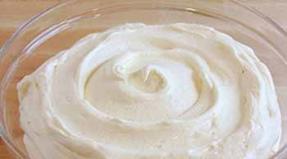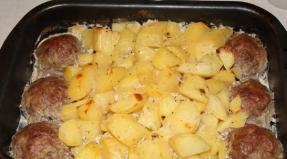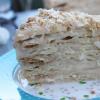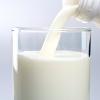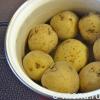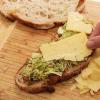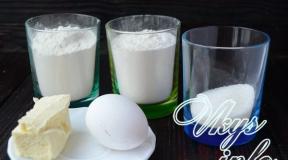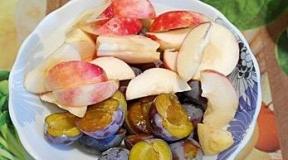Common pecan or Caria is a wonderful nut from North America.
Pecan has vanilla flavor and chocolate aroma. Its merits were first appreciated by the Indian tribes of the American prairies. About 200 years ago, the plant came to Europe, and now it is grown in Russia.
[Hide]
Botanical description
The biological name of the plant is Caria Illinois. A more familiar name is common pecan. Belongs to the Hickory family, the Hickory genus. These deciduous trees in their homeland can grow as tall as a twelve-story house. Old age carias reach 2 meters in girth.
From one mature pecan tree, you can harvest up to 15 kg of nuts, and from an old one - 200.
Appearance description:
- thick trunk with brown wrinkled bark;
- lush spreading crown;
- large, smooth, narrow leaves;
- long, fluffy earrings at the ends of young shoots during flowering.
Photo of pecan
Blooms in May - June. In our conditions, this protects the peduncles from spring frosts. The trees are pollinated by the wind.
How does a pecan grow?
For the first 4-5 years, the seedling grows extremely slowly, adding no more than 30 cm in height. It is believed that at this time the root system of the future tree is being formed.
Where does it grow?
The nut grows on fertile, as well as loose and well-moisturized soils. It is found in the United States (here walnut farming is practiced for commercial purposes) in the states of Iowa and Indiana, in the Mississippi valleys and the prairies of Texas.
European subspecies are common:
- in Crimea;
- in the Caucasus;
- in Central Asia.
Some varieties of Caria Illinois are resistant to frost. Young trees are able to withstand -30. Therefore, the variety will probably spread to the northern regions.
Varieties and varieties
Today, there are about 150 known varieties of pecans.
The following varieties are most popular in Europe:
- Success;
- Textan;
- Indiana;
- Major;
- Stewart;
- Greenriver.
All these species are distinguished by their unpretentiousness to the composition of the soil, drought resistance and stable fruiting. They grow poorly only on marshy and acidic soils. The Major variety is considered one of the most cold-resistant. But for growing nuts in our climate, the endurance of the shoots is not enough. Since the fruits appear relatively late - at the end of October, most of them simply do not have time to ripen.
In addition, the following super-northern varieties are now popular:
- Snaps;
- Dearstand;
- Carlson-3;
- Campbell NS-4;
- Lucas.
The super-northerly pecans are not suitable for commercial cultivation, as their fruits are the smallest of all - no more than 2.5 cm.
Description and properties of fruits
Fruits in the scientific world are called drupes. They are collected on a tree in bunches (5-10 pieces), the length of each nut is about 4 cm. The shell is smooth and dense. When ripe, it turns brown, dries and cracks, exposing a kernel similar to a walnut. But pecans are sweeter and do not contain any partitions inside.
You can learn about the beneficial properties of pecans in the video from the JitZdorovo channel.
Nutritional value
Most of these oils are composed of mono- and polyunsaturated fatty acids. A tenth of a kilogram of this product contains 9 g of protein, 14 g of carbohydrates, including dietary fiber.
In a large chicken egg, considered a source of protein, the latter is even less than 100 g of pecans.
Comparative table of the mineral and vitamin composition of nuts (per 100g of product):
Exotic Pecan - Contains a high amount of the most valuable fat-soluble vitamins A and E.
Benefit
Caria Illinois nuts are widely used in cooking. Pecan nuts have been used as food by Indian tribes for a long time. The fruits were harvested for future use, they were eaten in case of an unsuccessful hunt. Priests and healers, rubbing nuts, received "milk", which they watered wounded soldiers, healed the weakened and strengthened the health of children.
But the main thing in pecans is a beneficial effect on the body, which is why they are recommended to be added to food for patients with diseases of the heart, eyes and all elderly people.
Vitamin A (retinol) - ensures the functioning of the retina, maintains visual acuity and the health of our eyes. In addition, retinol is involved in the development of all systems of the child's body.
Vitamin E (tocopherol) is a natural antioxidant:
- stabilizes membranes, protects them from oxidation;
- maintains health at the cellular level.
Deficiency of this vitamin causes aging and deterioration of the body. Tocopherol, together with unsaturated fatty acids, protects the walls of the arteries from damage and inflammation, slows down the growth of cholesterol plaques, saving them from heart attacks and strokes. Moreover, vegetable pecan oils literally remove "bad" high-density cholesterol from the bloodstream, while the content of "good" cholesterol increases.
These same substances, balanced with a complex of other vitamins and minerals, regulate the functions of human immunity. Reducing the force of radical reactions that damage membranes and DNA. Tocopherol and fatty acids are involved in anti-tumor defense.
The benefits of pecan are highlighted in a video published by the Culture of Prosperity channel.
You can also get from pecan:
- Pecan oil. Used internally for colds, heart disease. Outwardly - for skin diseases, as well as during massage procedures.
- Trunk wood. Prized by furniture manufacturers. It is believed to be harder than oak.
Harm
Even these healthy nuts can be harmful:
- Figure and body weight. People who watch their weight need to remember that the fruits of Caria are very high in calories.
- Allergies. Do not eat this product if you cannot tolerate peanuts, hazelnuts or walnuts. Also described are cases of allergic reactions in children suffering from diathesis.
- Digestive disorders. Occur with uncontrolled consumption of nuts.
Planting and growing
Caria reproduces in the following ways:
- seeds;
- cuttings;
- budding;
- vaccination.
Growing pecans from seeds is easier than growing from seedlings. The latter often die during transplantation, since the root system of a young plant is vulnerable.
Preparation and selection of a landing site
It is important that in the place of planting both seeds and subsequently seedlings there is a deep fertile soil layer. Water in the beds should not stagnate. Choose an area that is lighted so that trees do not grow in the shade of a house or other structures.
How and when to plant?
Mature seeds are sown in the ground in autumn or spring. If the spring option is chosen, seed stratification must be carried out. To do this, they are kept in a humid environment at a temperature of 2-4 degrees for 2 months. Sowing is best in April.
Beds and furrows are formed before planting. It is better to leave the distance between the rows at least 1 m. The depth of planting seeds in loose soil is 7-8 mm. After planting, the garden bed is watered and covered, sprinkled with sawdust, chips or cut grass. This will protect the seeds from the scorching sun, showers and create comfortable conditions for germination.
Nut germination is better when planting in spring. The first shoots appear in a month. Strong and vigorous seedlings are transplanted to a permanent place at the age of one year. Others - after 2-3 years, when they reach a height of at least 50 cm.
At the place where the walnut tree will grow, they dig a planting hole at least 60 cm deep and wide. When transplanting, they try not to damage the root system of a young pecan. Gently spreading the roots of the plant in the hole, sprinkle them with loose soil on top. After that, watering thoroughly, you should sprinkle the ground with peat or sawdust.
Pecan care, fertilization and feeding
The basis of plant care is regular watering and feeding. In summer, make sure that the soil does not dry out. The roots of the tree must be constantly moistened, therefore, during dry periods, watering is required more often and more abundantly. Some gardeners recommend periodically moisturizing the leaves using a shower watering method.
It is not so easy to find pecans in our country, and if it works out, then because of the price, many will refuse to buy it. And yet nutritionists never tire of repeating the benefits of the ingredient for women, men, children and the elderly. With the right approach, this nutritious delicacy can activate processes that have a positive effect on the overall health of the body.
The products are famous for their therapeutic properties, preventive effects. Finally, pecan has a great flavor that can be used in culinary and pastry industries.
general information
The beneficial properties of a valuable food ingredient were known many years ago, and not in one country, but in different parts of the world. The plant, which belongs to the nut family, thrives well in humid and hot climates. In particular, pecans actively bear fruit on those parts of the land that are washed by large bodies of water.
Pecan is the fruit of a deciduous tree that can produce crops for up to 300 years. Sometimes the height of these trees reaches 40 m. The nuts themselves are elongated, their shells are brown. On average, the size of a pecan does not exceed 3 cm in length.
Under the shell are deep beige kernels. In appearance, they very much resemble walnuts, which is not surprising, given the close family ties of trees. But the pecans have no partitions, and the taste of the kernels is softer and lacks tart notes.

The quality, useful and harmful properties of pecan, its taste are greatly influenced by the timeliness of the harvest, the correctness of its processing. If the products are harvested before they are fully ripe, their characteristics will not please gourmets and amateurs alike. Therefore, before buying a pecan, you should definitely try it. It makes no sense to buy products that do not taste good, just to benefit from them. The chemical composition of such nuclei is far from the optimal and desired effect on the body, they will not have.
Pecan composition and properties
Pecans are very unusual and controversial nuts. 100 g of the product contains 690 kcal, but products from it can be included in the diet for diets. Products, which are famous for their energy performance, contain many useful substances:
- An almost complete list of B vitamins. They are necessary to maintain metabolic processes and nutrition of muscle tissue, to start the regeneration of cells and colonies. Without them, the normal functioning of the nervous system and the body's immune defense is impossible. B vitamins are involved in the synthesis of blood cells and the formation of cellular DNA.
Tip: You can make healthy and nutritious milk from pecans. To do this, grind the kernels in a mortar to a homogeneous state and dilute with water. The concentration of the composition can be adjusted independently. This drink is especially useful for children and pregnant women. It perfectly replenishes energy and strength.

- Vitamin C. Strengthens the immune system and takes part in collagen synthesis.
- Vitamin E. A substance that helps to restore and maintain youth. Regular consumption of pecans allows women to maintain their beauty for many years.
- Vitamin K. Active regulator of blood coagulation processes. It promotes faster recovery in people who have undergone surgery.
- Antioxidants Nutritionists have counted several dozen substances in pecans that can prevent the damaging effects of free radicals on the tissues of the human body. These compounds also protect against heart disease, improve general condition, and restore lightness and vigor.
- Unsaturated fatty acids. Participants in metabolic processes that have a positive effect on the functionality of the brain and reduce the levels of harmful cholesterol in the blood.
- Minerals. Pecan contains calcium, potassium, magnesium, iron, phosphorus, zinc, copper, fluorine, selenium and manganese. Each element has specific functions that promote health and reduce the risk of disease.
The health benefits and harms of unique nuts are directly related to their freshness. The oily texture of the kernels is not capable of maintaining the listed substances in their optimal chemical form for a long time. Violation of the storage conditions for products leads to their deterioration. If the fruits are bitter, it is better to refuse to use them. In any case, they will no longer have a positive effect.
Health Benefits of Pecans
Initially, peoples of many countries included pecans in their diets only because of its significant nutritional value. People made large stocks of produce in case of famine. Today they are more of a delicacy. Their presence in the menu can lead to the following results:
- The body fat will decrease and the muscle mass will increase. At the same time, the nuts will also satisfy the feeling of hunger, which will reduce the daily calorie content of the diet. According to doctors, it is enough to eat only 2 pecans daily for the product to lead to weight loss.
- Chronic fatigue disappears, signs of depression disappear, and the likelihood of developing nervous disorders decreases.
- Prevention of vitamin deficiency and mineral deficiency in tissues is carried out.
- Effective prevention of oncology and early aging of the body is carried out.
- Pecans are very good for men. It normalizes the reproductive system by increasing the level of testosterone in the blood.
- The use of products increases the level of hemoglobin, preventing anemia. The minerals in nut kernels fight bacteria and viruses.
- Women who include pecans in their diets report improved quality of hair, nails and skin. And in nursing mothers, the nutritional value of breast milk increases.

The use of pecans in childhood is the key to the normal development and growth of the body. In the elderly, the product improves the quality of life, eliminating many unpleasant moments. For all of the above effects, the ingredient can be eaten raw, fried, or dried. It is often used to prepare various healthy desserts and sweets.
The harm and danger of pecan nuts
The high calorie content and abundance of active substances in the composition can play a cruel joke with people who abuse pecans. You cannot eat more than 100 g of nuts per day, and it is better not to bring it to such a high rate. Violation of the rule can lead to the following consequences:
- The product simply will not be absorbed, provoking an excessive load on the digestive organs.
- Allergies may develop in the form of headaches, rashes on the oral mucosa, and indigestion.
- With a tendency to overweight, active weight gain will begin.

The introduction of pecan into the diet is strictly prohibited for fatty liver, nut allergies, under the age of 3 years. For pregnant women, it is enough to use the product in an amount of 2 pieces, up to 3 times a week.
Rules for the selection and storage of pecans
Today in stores, many nuts are sold peeled, wrapped in plastic. In the case of pecans, this is not the best solution. When choosing products, you should pay attention to the following points:
- We take only unpeeled fruits with a dense, but thin shell without chips, cracks and darkening.
- Nuts must be tasted, they should not have bitterness in their taste.
- You should not take elements that are too light or those that rattle if you shake them.

It is also better to store the pecans right in the shell. A refrigerator or freezer is ideal for this. The products should be pre-inspected and sealed in containers. In the refrigerator, stocks can last up to 4 months, in the freezer - up to 6 months. If the items start to give off a rancid odor, it is better to throw them away and not use in food.
Pecan butter is no less useful. It is obtained by cold pressing of fruits, due to which the finished product retains the most useful substances in its composition. Studies have shown that ingested product has a beneficial effect on the state of the circulatory system. External application of the mass allows you to fight the signs of aging. Another healing product helps to strengthen the immune system and reduces the risk of colds.
Pecans are more than just an excellent substitute for animal protein, they are many more beneficial nutrients, including antioxidants. And unsaturated fatty acids (mono- and poly-) make this exotic nut the ideal core food.
The homeland of pecans is considered to be the central and eastern regions of North America, as well as the valleys of Mexican rivers. Since ancient times, they have been actively collected and eaten by the Indians.
Inside, it looks like a walnut, but it has a smoother elongated shell and a softer, softer taste without bitterness. The set of nutrients also differs. This North American nut has a special and unique flavor.
Pecans are a treasure trove of energy. 100 g contains 690 calories! In addition, these delicate, creamy and oily textured nuts are packed with vitamins, minerals and natural antioxidants.
The mineral profile of the product includes: selenium and zinc, magnesium and iron, calcium and potassium, and manganese. Among the vitamins, vitamin E and B-complex vitamins should be recognized as favorites.
One handful of pecans (28 g) contains 2% of the daily value of fat-soluble vitamin E, which has proven itself well in combating the negative effects of pollution and sunlight. It also reduces the risk of viral and other infections.

Returning to the B vitamins, it should be noted:
- vitamin B1, or thiamine (12% in one handful): participates in the breakdown of carbohydrates and proteins, is necessary for the nutrition of nervous and muscle tissue;
- vitamin B2, or riboflavin (2%): participates in the metabolism of carbohydrates, proteins and fats, in cell division, helps in tissue regeneration and growth;
- vitamin B3, or niacin (2%): participates in the synthesis of fats, plays an important role in the functioning of the nervous system;
- folic acid (2%): promotes the formation of red blood cells and other types of cells, plays an important role in the formation of DNA;
- vitamin B5, or pantothenic acid (2%): involved in the energy metabolism of carbohydrates, fats and proteins;
- vitamin B6, or pyridoxine (3%): required for the formation of red blood cells, the synthesis of lipids for the immune and nervous systems, is a coenzyme in the complex process of formation of neurotransmitters.
A diet rich in all of these vitamins can give you a lot of vitality, smooth strong nails, glowing skin, protect from muscle cramps and cramps, increase tissue elasticity, improve hair condition and lower blood sugar. An excellent perspective in my opinion.
Pecans also contain modest amounts of ascorbic acid (a water-soluble vitamin C needed for collagen synthesis and antioxidant protection) and 1% daily value of fat-soluble vitamin K (regulates blood clotting and helps in saturating bones with calcium).
By the way, about antioxidants. Let's take a look at them in the pecans: zeaxanthin, lutein, beta-carotene, etc. They protect us from harmful free radicals and their damaging effects at the cellular level. These wonderful substances give a supply of vigor and energy, preserve youth, protect against heart disease and cancer.
Beneficial features
More "good" cholesterol
This peerless nut is rich in monounsaturated fats like oleic acid, which helps in increasing so-called "good" cholesterol and lowering "bad" cholesterol. The fatty acids in pecans are beneficial for their antioxidant properties. They protect the human body from cancer, coronary artery disease and reduce the risk of getting a heart attack.
Gerontology
One of the key uses of antioxidants by nature itself is to fight aging. For centuries, gerontological scientists have been looking for a cure for this natural process. The dream of eternal youth is too tempting to just give up. But so far, the most effective are the antioxidants that pecans are so rich in. Don't miss this opportunity!
For sight
The carotene found in pecans is good for eyesight. Prevents eye diseases associated with aging, excessive visual stress and stress.
Oculists recommend that everyone with vision problems include as many carotene-rich foods as possible in their diet. In addition to carrots and cod liver, carotene can be found in dairy products, eggs, green and yellow vegetables.
We clean the blood with nuts
"Nut" carotene helps in cleansing from poisons, which are full in the bloodstream of every civilized person. An environmentally unfriendly environment and unhealthy food products only exacerbate the situation. Along with the antitoxic properties, carotene prevents atherosclerosis by preventing the deposition of fatty oxidation products on the walls of blood vessels.
Anti-cancer properties
Scientists are confident that the antioxidants in pecans can play a good role in the prevention of certain types of cancer. Nuts are especially effective against prostate cancer, duodenal cancer, breast cancer and lung cancer. This entire spectrum of anti-cancer benefits of pecans is based on real-life medical research. In other words, he can be trusted.
Harm and contraindications
In large quantities, high-calorie pecans can harm your figure, especially since they satisfy hunger less intensely than the same pistachios. Like many other nut crops, they can trigger an allergic reaction. Get help at the first sign!
The pecan tree is tall, deciduous with large fruits. It reaches a height of 60 meters, grows in loose soil with abundant moisture. This plant provides healthy and nutritious nuts that are widely used in cooking, medicine and cosmetology.
Pecan tree: description
How the pecan tree growsThe pecan tree is a member of the Hickory genus, the Walnut family. This plant is considered a close relative of the walnut. His homeland is North America. The climate of the continent is suitable for growing and domesticating trees.
The maximum tree height is 60 meters. The life span of the plant is 400 years, during this time the plant is actively bearing fruit. The pecan tree has a wide spreading crown, with a diameter of up to 40 m. The leaves are round, smooth and dense. Flowers are male and female, formed exclusively at the ends of young shoots. In a favorable climate, the flowering process begins in May and ends in early June. Pollination and the breeding process takes place mainly with the help of wind.
The fruits of the plant are of particular importance. They are a valuable source of vitamins, trace elements and nutrients. They are widely used in cooking, medicine and cosmetology. Nuts fill the body with nutrients, help to cope with many diseases and restore the structure of the skin and hair.
Habitat and distribution
Not many people know where the pecan grows. This is due to the lack of plantations in Russia, Ukraine and other countries of the former USSR. The plant is native to North America. Large plantations are recorded along the banks of the Mississippi River. This is due to the optimal conditions for growth and reproduction.

The largest plantings can be found in the southeastern United States and Central Asia. The main export of useful fruits is carried out directly from these territories. In the Russian Federation, minor plantings of the plant are recorded in the Crimea and the Caucasus. The tree has no industrial value.
How to grow pecans yourself
The pecan tree can theoretically be grown on its own. However, for this action it is necessary to follow a certain algorithm and create optimal conditions for the plant. So, the process of culture propagation is carried out by seed and vegetative method.
The fruits of the plant. Nuts that have fallen to the ground are considered ripe and suitable for sowing. Small grooves are made in the ground, the depth of which is 10 cm. Nuts are sown into the resulting holes. A distance of 1 m should be observed between the seeds. In the spring, all the seedlings sprout, to a single one.

At the end of April, seeds can be sown, having previously stratified. Before that, they must be soaked for two days in water and then sent to wet sawdust. The substrate should always be moist, and the ambient temperature should not exceed 4 degrees. The transplant is carried out in a warm, sunny place where there is no stagnation of moisture. If the nuts will immediately be planted in a permanent place, it must be filled with compost.
For the first time, the tree grows very slowly, during this period, the root system grows. By the age of three, the plant height does not exceed 50 cm. When this parameter is reached, the sprout can be transplanted to a permanent habitat. Care for the pecan is thorough, it is necessary to constantly monitor the condition of the soil and water the plant abundantly. Young seedlings need protection, feeding and watering. The first fruiting is recorded 10 years after planting.
The main feature of the culture is the absence of a predisposition to disease. Nuts are not touched by the moth, so their shell is always whole. Visually, they are similar to olives, which is why pecans are often called olive nuts.
Growing an exotic plant in your own summer cottage is not an easy process. The tree requires certain conditions, attitude and care. This culture is subject only to patient people, it must be constantly replanted and the condition of the soil monitored. In gratitude for all the work, the tree will thank you with a large harvest.
Now that exotic plant seeds are available and sold in stores, many gardeners are addicted to growing tropical plants. This is done in order to obtain unusual and vibrant flowers, ornamental foliage or fruits. Recently, hickory seeds, known as pecans, have appeared on the shelves of flower shops. Can we grow pecans with us? If you live in southern latitudes, then yes, but if in places with colder climates and harsh winters, then it is unlikely. Before you set out to grow pecans at home, you need to familiarize yourself with the botanical features of this plant.
Is a nutritious fruit of the hickory tree. Hickory is native to North America, although it is now successfully cultivated in the Caucasus and Kazakhstan. In Russia, hickory is cultivated only as an ornamental plant in moderately cold regions.
The hickory tree reaches a height of 35 to 50 meters, has a regular spherical shape and valuable wood. Hickory has a taproot that goes deep into the ground. Saplings are extremely sensitive, and can die if the root is injured, therefore, for reproduction I often use grafting, white pecan acts as a rootstock. Hickory trees are heterosexual, that is, only female flowers grow on one tree, and only male flowers on the other.
These characteristics are quite enough to understand how far it is possible to grow pecans at home. It is unlikely that you will be able to place a fifty-meter giant with a powerful rhizome and a massive crown in the house. And in order for a tree to start bearing fruit, it is necessary to grow a second one, for successful pollination.
The conclusion is this: growing pecans at home is impossible, and on the site only if you live in an area with mild winters. Some hybrid varieties of pecans allegedly tolerate cold snaps down to -36, but in practice they hopelessly freeze out.
If it is possible to grow pecans outdoors, it is better to use seedlings rather than growing pecans from walnuts. But there is one drawback - it is difficult and expensive to get seedlings, and hickory seeds are sold in supermarkets and flower shops. Pecans are not specially germinated; they are sown in the soil before winter, without prior stratification. It is better to sow several nuts at once, since pecans do not differ in good germination.
As for the care of seedlings and young plants, their roots must be constantly moistened and the soil well fertilized. The seedling must be tied to a support and ensure good watering. For less evaporation of moisture, the soil around it is recommended to mulch. From time to time, pruning of the upper branches is carried out. Under favorable conditions, hickory will begin to bear fruit as early as the fifth year after planting.
